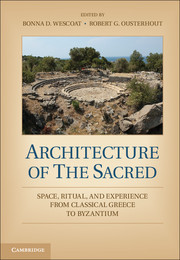Description
Architecture of the Sacred
Space, Ritual, and Experience from Classical Greece to Byzantium
Coordinators: Wescoat Bonna D., Ousterhout Robert G.
This book investigates the role of architecture in the construction of sacred experience in ancient Greek, Roman, Jewish, Christian and Byzantine cultures.
Language: English
Subject for Architecture of the Sacred:
Publication date: 10-2014
410 p. · 16.7x24.9 cm · Paperback
410 p. · 16.7x24.9 cm · Paperback
Description
/li>Contents
/li>Biography
/li>
In this book, a distinguished team of authors explores the way space, place, architecture, and ritual interact to construct sacred experience in the historical cultures of the eastern Mediterranean. Essays address fundamental issues and features that enable buildings to perform as spiritually transformative spaces in ancient Greek, Roman, Jewish, early Christian, and Byzantine civilizations. Collectively they demonstrate the multiple ways in which works of architecture and their settings were active agents in the ritual process. Architecture did not merely host events; rather, it magnified and elevated them, interacting with rituals facilitating the construction of ceremony. This book examines comparatively the ways in which ideas and situations generated by the interaction of place, built environment, ritual action, and memory contributed to the cultural formulation of the sacred experience in different religious faiths.
Preface Robert G. Ousterhout and Bonna D. Wescoat; 1. Material culture and ritual: state of the question Jaś Elsner; 2. Monumental steps and the shaping of ceremony Mary B. Hollinshead; 3. Coming and going in the sanctuary of the great gods, Samothrace Bonna D. Wescoat; 4. Gateways to the mysteries: the Roman propylon and in the City Eleusinion Margaret M. Miles; 5. Architecture and ritual in Ilion, Athens, and Rome C. Brian Rose; 6. The same, but different: the temple of Jupiter Optimus Maximus through time Ellen Perry; 7. Mapping sacrifice on bodies and spaces in ancient Judaism and early Christianity Joan Branham; 8. The 'foundation deposit' from the Dura Europos Synagogue reconsidered Jodi Magness; 9. Sight lines of sanctity at Late Antique Martyria Ann Marie Yasin; 10. The sanctity of place and the sanctity of buildings: Jerusalem vs Constantinople Robert G. Ousterhout; 11. Divine light: constructing the immaterial in Byzantine art and architecture Slobodan Ćurčić; 12. Architecture as a definer of sanctity in the monastery tou Libos in Constantinople Vasileios Marinis; Afterword Bonna D. Wescoat and Robert G. Ousterhout.
Bonna D. Wescoat is Associate Professor of Art History at Emory University, Atlanta and Director of the Institute of Fine Arts excavations at the Sanctuary of the Great Gods, Samothrace, Greece. Her research concentrates on ancient Greek sacred architecture and iconography. Recent works include The Temple of Athena at Assos (2012) and The Monuments of the Eastern Hill (Samothrace) (2015).
Robert G. Ousterhout is Professor of the History of Art at the University of Pennsylvania, where he directs the Center for Ancient Studies. A specialist in Byzantine art and architecture, his research focuses on the vanishing architectural heritage of the Eastern Mediterranean. He is the author of numerous books, including Master Builders of Byzantium, 2nd edition (2008), The Byzantine Monuments of the Evros/Meric River Valley (2007, with Ch. Bakirtzis), and A Byzantine Settlement in Cappadocia, 2nd edition (2011).
Robert G. Ousterhout is Professor of the History of Art at the University of Pennsylvania, where he directs the Center for Ancient Studies. A specialist in Byzantine art and architecture, his research focuses on the vanishing architectural heritage of the Eastern Mediterranean. He is the author of numerous books, including Master Builders of Byzantium, 2nd edition (2008), The Byzantine Monuments of the Evros/Meric River Valley (2007, with Ch. Bakirtzis), and A Byzantine Settlement in Cappadocia, 2nd edition (2011).
© 2024 LAVOISIER S.A.S.




